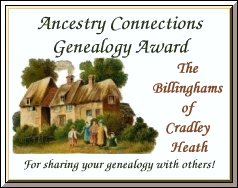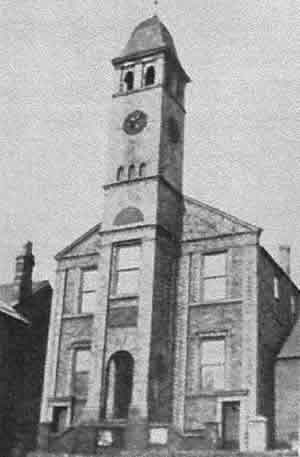
New Page with all available Censuses.
The Billinghams National Index of Burials 1538 to Present
Baptism and Births of Billinghams from 1585 to Present.
Earl of Dudleys Rent Books for Billinghams.
Baptism dates1785-1808 from St Peters Cradley and Burials 1785-1805
Billinghams who lost their lives serving their country WW1 and WW2
The Conditions the Cradley Chainmakers
The Famous and Infamous Billinghams. Featuring Benny Fiddler, His Grandson Blind Arthur, and more!!
Billingham Family Lines very good section for research you may find a link here.
Benjamin Billingham Son of John and Pheobe Billingham Born 1811-1895.
Joseph Billingham Son of Emmanuel Billingham born 1813.
Benjamin Billingham Son of Emmanuel Billingham
Soloman Billingham Emmanuels Son

The Billinghams of Cradley
Updated February 2006
The Billinghams and Graingers Lane Methodist Church Cradley Heath.
***
The early history of the Graingers lane Methodist Church started with a group of Wesleyan Methodists holding their meeting in a nailshop near to Five Ways later known as Tibbetts Gardens.
They then moved to a nearby cottage.
Later building their first church at Graingers lane in 1841.
In 1830 the membership was about forty, nine were Tibbetts and seven were Billinghams.
William Tibbetts 1783-1855 and his wife Mary supplied the meeting room in the early days (1827) At Tibbett Gardens. William became a teacher at the Sabbath school.
********
The Billinghams and Tibbetts seem to have been quite active Church people before the Graingers lane church see extract below taken from Cradley Parish Records.
Pew (seat) rents for Cradley Parish Church
1820-21. Pew 41, Mrs Billingham, Mary Beesley, Sarah Harper, and Ann Hodgetts.
1822-25, Pew 35, Aaron Attwood, Joseph Attwood, William Billingham, Thomas Tibbetts,
Joseph Appleby, Mirah and Hannah Worton and mary and Phebe Hodgetts.
The rents were 9d per quarter.
UPDATE 2007
It was with a heavy heart that, a couple of weeks ago, we reported the loss of yet another of the Black Country's fine churches. Graingers Lane Methodist Church held its final service last weekend, ending almost 180 years of worship in this little corner of Cradley Heath.
Although the church had humble beginnings, it was immediately connected with some of the foremost members of Cradley Heath society, including the renowned chain-making families of Billingham and Woodhouse, and the Tibbetts clan, who operated a high class butchers in Cradley Heath. While the future of the building is now uncertain, Jack Porter, of Gladstone Road in Wollaston, here brings us an erudite history of this religious landmark, which will be much missed by the residents of Chain Town.
"Reading your account of the closure of Graingers Lane Methodist Church on Sunday 18th July, and saddened that another once great bastion of Methodism is falling, it would be worthwhile to reflect on the faith and efforts of those who built it. I have not said much about the last eighty or so years, as they are still in public memory and many will recall their own association and the 'Glory Days' they knew, not only in religion, but also in youth work and the many excellent cultural and social occasions.
"Primitive Methodism sprang up in an almost similar way to how Wesleyan Methodism had sprung from the Church of England just a few generations before. The first general meeting was held at Tunstall, and the first Primitive Methodist Conference was held in Hull in 1820.
"Primitive Methodism spread, and with the growth of members came the growth of Circuits, such as the Staffordshire and Shropshire and the Worcestershire and Hereford, the parent circuit being Tunstall. Darlaston became a circuit in 1820, and the Dudley circuit was formed in 1833 with two preachers and 700 members, the first Chapel being built there in 1830. There was a similar growth in the surrounding areas.
"Missioners went out to spread the message. Samson Turner and James Bonser were early missioners and organisers of the Darlaston circuit, and though there was early opposition, even imprisonment, there were conversions and rapid growth.
"Cradley Heath, in the early part of the nineteenth century, saw increasing industrialisation, with its wealth for some and squalor for most. As a result of the preaching of Thomas Brownsword and James Bonser from the Darlaston Circuit preaching in Cradley Heath, a few people were converted. One evangelist recorded that on 14th February 1821, 'I preached at Cradley Heath. Many in great distress, 8 or 9 professed to find peace'. These early converts formed themselves into a class, meeting in the open or in people's homes, supported by travelling preachers. One was John Batty, 'a fearless preacher', and another was John Ride or Riddle, who in April 1827 was released from the Darlaston Circuit to help the fledgling class organise and find a suitable place for worship. Its membership was then 27 souls.
"First they met in a nail shop in Tibbetts Garden, and then in two cottages which were altered to use as a church and Sunday School. This served until enthusiasm and growth demanded a more suitable building. A site lower down from Tibbetts Garden became available and a new church was erected and opened for worship in 1841. Soon, a Sunday School was also built. New galleries were added, and an imposing clock tower erected at the centre of the front. This soon became known as the 'Clock Chapel'.
"The Cradley Heath Primitive Methodist Society grew in numbers, and extensions were made, both to the church and the Sunday School. However, the new facilities did not meet with universal praise. Samuel Woodhouse, who became a pillar of the church for many years, wrote in the childhood recollections he compiled as a sixty five year old man in 1910:
'When the Old Chapel was enlarged, the ground floor was made to serve for another school room. It was about thirty feet by forty feet, with the ceiling about seven feet eight inches or eight feet high, badly lighted with a very small bedroom grate on either side of one chimney. One would draw, the other would blow, and was altogether unfit for the purpose. I mention this to show that some of the Leaders of the Church thought that anything would do for a Sunday School.'
"In 1871, a further five hundred square yards of land was purchased at the cost of £75, and in 1873, a new school was completed, costing £1,200. Another portion of land was also acquired.
"Meanwhile, construction problems began to show with the Clock Chapel, and finally there was rapid subsidence; the rear of the chapel became two feet lower than the front. There was other subsidence in the immediate area. Within a radius of 150 yards, forty houses were shattered and dilapidated. Church services were held in the school while repairs were carried out. The damage was estimated at £1,200, but only £350 in compensation was paid out over five years.
"The church opened again in 1889, but the sloping floors and tilted pews made the situation untenable, and the decision was made to abandon the Clock Chapel. It was offered for sale at £400, but a buyer was hard to find.
"During the ministry of Richard Lush, in 1900, came the decision to rebuild, and under the ministry of new minister Francis Brunskill a 'New Building Fund' was opened. £1,000 was promised, and then another £1,000. Plans were accepted from Ewen Harper and Brothers of Birmingham, and Joseph Meredith of Cradley was contracted to do the work. The Foundation Stone was laid on 2nd October by Dan Gill, an old scholar, and finally, on 24th September 1906, the door was opened by Mrs Burnett Smith, an author whose nom de plume was Annie S. Swan. The preacher on the occasion was professor A.S. Peake, the senior tutor at Hartley College in Manchester.
"A new organ was later installed, costing £750. Half of the money was given by the Andrew Carnegie Trust, and it was opened by Ernest Stevens, the local industrialist and benefactor. The opening organist was the delightfully named Reginald Goss Custard of St Margaret's in Westminster, who was assisted by Margaret Woodhouse, the wife of George Woodhouse. He was principal of one of the London Schools of Pianoforte, and the son of Samuel Woodhouse.
"In 1918 came the decision to liquidate all outstanding debts, and chiefly through the efforts of Henry and Frank Woodhouse more than £2,000 was raised to this effect.
"In 1920, the church purchased a house in Sydney Road to serve as a manse for its ministers, and the next decade saw the installation of several stained glass windows by the artist Henry A. Payne R.W.S. These included 'The Good Samaritan' in 1921, in memory of Samuel Woodhouse, 'Peace and Goodwill' in 1922 to the memory of those who fought and fell in the 1914-18 war, 'The Resurrection' in 1927, in place of the original 'Blessing the Children', which was moved to the school hall, and 'The Nativity' in 1930, in memory of Dan Gill J.P.
"The new century saw growing activity and an increase in both the membership of the church and the Sunday School, which at one time had more than 400 children and 45 teachers. Church life flourished in the numerous cultural, social and musical activities, and from the outstanding qualities and services of its carefully chosen ministers. A combination if these, together with the devotion, loyalty and generosity of its members, made Graingers Lane outstanding in the locality.
"However, there were signs of the changes to come. In 1966, it moved from a pastorate of 44 years into the normal circuit, sharing the churches of Dudley Wood, Bethesda, Trinity, and Christ Church. In September 1970, it was amalgamated with the nearby Christ Church, which then closed. Again, in 1973 new Conference Rules saw a further restructuring of the Church and Circuit.
"Sadly, since the end of the Second World War there has been another story to tell: the changes and loss of industries; the demolition of the old to accommodate the new; new road systems and estates; the consequent move of people and above all, the change in religious, cultural and social desires of people, have all contributed to the decline in church worship. Many churches, both nationally and locally, have been closed and demolished.
"Exactly a hundred years after Graingers Lane Primitive Methodist decided to rebuild for growth, it was decided that it could no longer continue and closed in July 2004. From a small seedling in 1821, with just eight or nine converts, the church grew and was very fruitful. It has seen the reign of eight monarchs, several wars and much national and local turmoil.
"Now, like a once fruitful tree, its life has some to an end; but hopefully, the memory and influence of Graingers Lane Methodist Church will live on."
